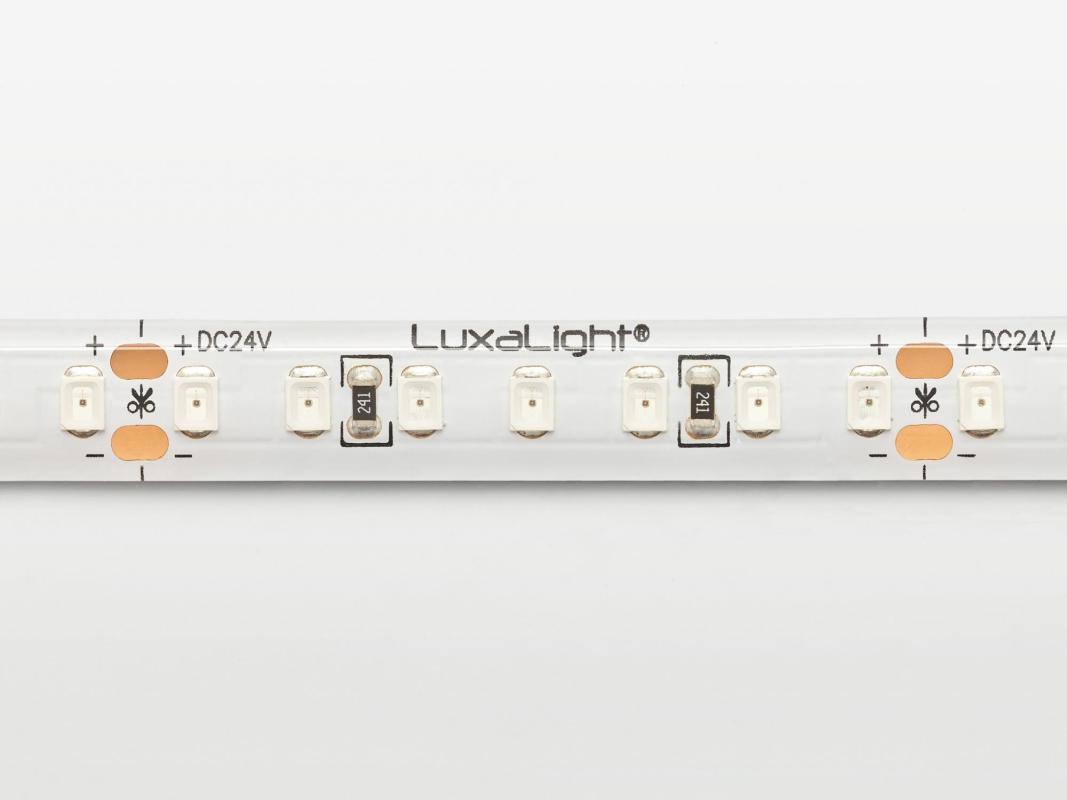LuxaLight Deep Red LED-strip 700nm Protected (24 Volt, 140 LEDs, 2835, IP64)
Technical specifications
| Value | Measuring distance |
|---|---|
| 142 μmol/m2 | 25 mm |
| 55,1 μmol/m2 | 50 mm |
| 30,2 μmol/m2 | 75 mm |
| 20 μmol/m2 | 100 mm |
| 6,7 μmol/m2 | 200 mm |
| 3,6 μmol/m2 | 300 mm |
| Value | Measuring distance |
|---|---|
| 42,3 W/m2 | 25 mm |
| 16,8 W/m2 | 50 mm |
| 9,34 W/m2 | 75 mm |
| 6,16 W/m2 | 100 mm |
| 2,11 W/m2 | 200 mm |
| 1,14 W/m2 | 300 mm |
| Symbol | Function |
|---|---|
| V+ | V+ |
| GND | Ground |
Product description
The LuxaLight Industrial LED Strip is designed for intensive industrial and commercial applications that require high radiation intensity and precise light distribution. With a 700nm deep red wavelength, this LED strip provides a powerful solution for processes that benefit from deep red light, such as plant growth stimulation, tissue regeneration, and specific industrial processes.
The LED strip features 140 LEDs per meter, ensuring high light density and uniform coverage for maximum performance. This strip is ideal for applications that require a flexible, space-saving light source, such as greenhouses, medical therapies, research environments, and other specialized industries. The strip can easily be integrated into custom fixtures or housing systems to meet specific application needs.
Key Features:
- 700nm Deep Red Wavelength: The 700nm deep red wavelength is ideal for applications that require deep red light, such as horticulture, biological research, and specific industrial processes. It is also used for promoting tissue regeneration and therapeutic applications.
- 140 LEDs per Meter: With 140 LEDs per meter, the strip delivers high light density, ensuring even light distribution across the surface for effective coverage and maximum performance.
- 24V Power Supply: The LED strip operates on a reliable 24V power supply, ensuring stable and consistent performance, perfect for demanding environments and applications.
- Flexible Design: The LED strip is flexible and can be easily adjusted or bent to fit into custom systems or enclosures, making it highly versatile for various configurations and applications.
- High Radiation Intensity: The LED strip provides high radiation intensity, ideal for applications requiring significant light output, such as plant growth and biological processes.
- Passive Cooling Required: The LED strip is designed to be passively cooled, meaning it must be integrated into a suitable enclosure or system that efficiently dissipates heat. Ensure the product does not overheat to maintain optimal performance and extend its lifespan.
- Semi-Finished Product for Customization: The LED strip is designed to be integrated into custom fixtures, housings, or systems depending on your specific needs. As a semi-finished product, it offers flexibility for a wide range of applications.
- PCB thickness: The PCB has a thickness of 3 oz/ft², providing robust support and efficient heat dissipation.
Applications:
- Horticulture & Agriculture: The 700nm deep red wavelength is effective for applications in horticulture where deep red light can support plant growth, particularly in enhancing photosynthesis and increasing yields in greenhouse and vertical farming environments.
- Biological Research: This LED strip is used in biological research, particularly in studies related to cellular regeneration, photobiomodulation (PBM) therapy, and stimulating collagen production. The 700nm deep red light helps promote healing and tissue repair.
- Medical Therapy: 700nm deep red light is used in phototherapy treatments, such as skin healing, anti-aging treatments, and muscle recovery, where deep red light stimulates cells and tissues to promote recovery.
- Food Industry: The LED strip can be used to stimulate growth in food production environments or in the pasteurization of certain food items that require exposure to deep red light.
- Industrial Material Curing (Non-UV): The deep red light can be used to cure coatings and materials that react to red wavelengths, ensuring effective curing processes in industrial environments.
- Cosmetic Industry: The LED strip is ideal for use in the cosmetic industry for skin treatments, such as wrinkle reduction, skin tone improvement, and collagen production stimulation.
Benefits:
- High Radiation Intensity: The LED strip provides high radiation intensity, helping to accelerate processes that require deep red light, improving productivity and performance.
- Flexible and Customizable: The flexible design of the strip allows easy integration into custom systems or housings, making it a versatile solution for a wide range of industrial, research, and medical applications.
- Even Light Distribution: With 140 LEDs per meter, the strip provides uniform and consistent light distribution, ensuring the light intensity is spread evenly across the surface for optimal results.









